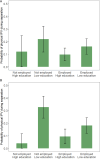Women's economic independence and physical intimate partner violence (IPV) during separation
- PMID: 40540519
- PMCID: PMC12180638
- DOI: 10.1371/journal.pone.0326529
Women's economic independence and physical intimate partner violence (IPV) during separation
Abstract
A growing number of studies have addressed the issue of intimate partner violence (IPV). While some studies have shown that women's economic independence reduces the risk of physical IPV, the empirical evidence is still inconclusive. In particular, little is known about the factors that are associated with the likelihood of experiencing physical IPV during the immediate separation process. We use data from the German Family Panel (pairfam) for the years 2009-2022. The analytical sample consists of women who went through a separation since the last interview (n = 786 person-years). We use logistic regression models to examine the determinants of physical IPV during separation. We find that mothers with minor children have significantly higher odds of experiencing physical IPV during separation than women who do not have minor children (OR=1.96, p=.006), controlling for key sociodemographic characteristics. Low education as well as non-employment are associated with higher risks of physical IPV during separation for both women with and without minor children. However, non-employment is a particular risk factor for mothers with lower levels of education. Divorce and separation, especially when minor children are involved, can be a highly stressful time when partner conflict escalates and, in some cases, culminates in violence against the partner. This paper highlights the importance of maternal labor market integration and economic independence as a lever to potentially reduce physical IPV and conflict during separation.
Copyright: © 2025 Molina et al. This is an open access article distributed under the terms of the Creative Commons Attribution License, which permits unrestricted use, distribution, and reproduction in any medium, provided the original author and source are credited.
Conflict of interest statement
The authors have declared that no competing interests exist.
Figures


Similar articles
-
Intimate Partner Violence Against Women in Burkina Faso During COVID-19: A Cross-Sectional Study.Inquiry. 2025 Jan-Dec;62:469580251345386. doi: 10.1177/00469580251345386. Epub 2025 Jun 24. Inquiry. 2025. PMID: 40553128 Free PMC article.
-
Women's lived experience of intimate partner violence manifestations during the breastfeeding period: a lifeworld hermeneutic study.Int Breastfeed J. 2024 Dec 16;19(1):80. doi: 10.1186/s13006-024-00690-5. Int Breastfeed J. 2024. PMID: 39681842 Free PMC article.
-
Intimate Partner Violence Against Indigenous Women and Association with Stunting and Anemia in Children: A Mixed Approach in Chimborazo-Ecuador.Matern Child Health J. 2025 Jul;29(7):932-947. doi: 10.1007/s10995-025-04117-3. Epub 2025 Jun 28. Matern Child Health J. 2025. PMID: 40580271 Free PMC article.
-
Maternal and neonatal outcomes of elective induction of labor.Evid Rep Technol Assess (Full Rep). 2009 Mar;(176):1-257. Evid Rep Technol Assess (Full Rep). 2009. PMID: 19408970 Free PMC article.
-
EORTC guidelines for the use of erythropoietic proteins in anaemic patients with cancer: 2006 update.Eur J Cancer. 2007 Jan;43(2):258-70. doi: 10.1016/j.ejca.2006.10.014. Epub 2006 Dec 19. Eur J Cancer. 2007. PMID: 17182241
Cited by
-
Economic deprivation and intimate partner violence in Germany.PLoS One. 2025 Aug 18;20(8):e0329930. doi: 10.1371/journal.pone.0329930. eCollection 2025. PLoS One. 2025. PMID: 40824950 Free PMC article.
References
-
- World Health Organization, London School of Hygiene and Tropical Medicine editors. Preventing intimate partner and sexual violence against women: taking action and generating evidence. 2010. Accessed 2024 November 9 https://www.who.int/publications/i/item/9789241564007.
-
- Walters ML, Chen J, Breiding MJ. The National intimate partner and sexual violence survey: 2010 findings on victimization by sexual orientation. Nat Center Injury Prevent Control Centers Dis Cont Prevent. 2013. doi: 10.1037/e541272013-001 - DOI
-
- Sillito CL. Physical health effects of intimate partner abuse. J Family Issues. 2012;33(11):1520–39. doi: 10.1177/0192513x12448742 - DOI
MeSH terms
LinkOut - more resources
Full Text Sources
Medical

